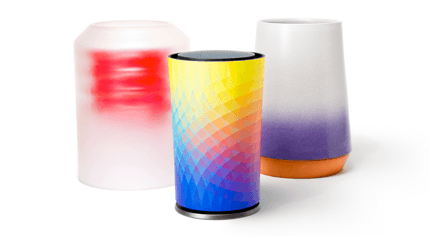Google gives unloved Wi-Fi routers some creative shell designs

By now, it’s no secret that the only way to get a slow Wi-Fi connection fixed is to keep the router out in an open space. However, given its dull design with various wires sticking out, no homeowner wants to put their boring-looking router in a noticeable spot in their house. As a result, Google and TP-Link decided to introduce the OnHub Wi-Fi in August.
Although the design and colors are fairly basic with a selection between navy or black, it was a great aesthetic upgrade from the standard routers on the market. To keep people interested in upgrading their Wi-Fi platforms, Google recently announced router shells with creative designs for specific units.
What you need to know about the shells
The Google-produced router shells come in three options: a split space grey and black, a split white and gold, and a premium wood design. The three shell designs are available at the Google Store which cost between $29-$39 in the US. The appearances are quite classy and support the search giant’s goal to keep the routers in plain sight rather than tucked away in bookcases or under tables. The recent additions allowed the users to customize their own shells, but the covers are limited only by the artist’s creativity. The company wants to get as much design input as possible to help them market the routers. All designs would have to be produced by the users themselves, and pictures will be displayed on the special section of the OnHub Makers website. If you’re interested in making one, you can download the 2D and 3D plans on the OnHub Maker (https://onhubmakers.withgoogle.com/). Google believes that it’s the most effective way to improve Internet strength and reliability in homes.
New OnHub router with fresh design
In October, Google released their second OnHub router that is produced by ASUS. Compared to the original, its wider base than the ones by TP-Link and the blue LED light is now at the bottom instead of the top. One of its unique features is the Wave Control that allows you to boost the Internet speed of a particular device. But, you have to first set said device as a priority on the Google OnHub control app. There’s also the “smart antenna algorithm” that allows the network to choose the strongest internet combination to produce the best speed in its 360-degree coverage. Unfortunately, it’s not cheap, and currently costs $219.99.
Is it worth the shot?
Google’s goal seems promising from the number of support it has received on its OnHub page for the design idea. But, only time can tell if this marketing tactic will be able to help the sales of their TP-Link and ASUS-produced routers. Because, USAToday mentioned that “Google wants you to learn not only to tolerate your router but to love it, just as you may love the devices that rely on it for Internet.”
In terms of performance, the two router models promise to give the same experience, apart from ASUS’ few fancy new features. The Wave Control is a bit gimmicky, but promising by redirecting more bandwidth to a priority device with just a wave of a hand on top of the router. As a mainstream wireless networking option with more advanced features, Google has a winner with their ASUS router – except for its high end price tag.
Whether or not the marketing tactic is successful, it’s a great attempt to garner interest for a product that has long been stagnant on the market. After all, Google has great vision and it wants to encourage people to keep their routers out in the open, and the new design changes will be able to support said cause. What do you think of Google’s creative shell designs?
ArTechyGirl has been invited to guest post by various reputable websites. She was a member of a group blog Techiedoodlers but now, she is looking to create her own space in the blogosphere. She also travels worldwide to know the latest technology from the west to the east. Watch out for her blog soon!





